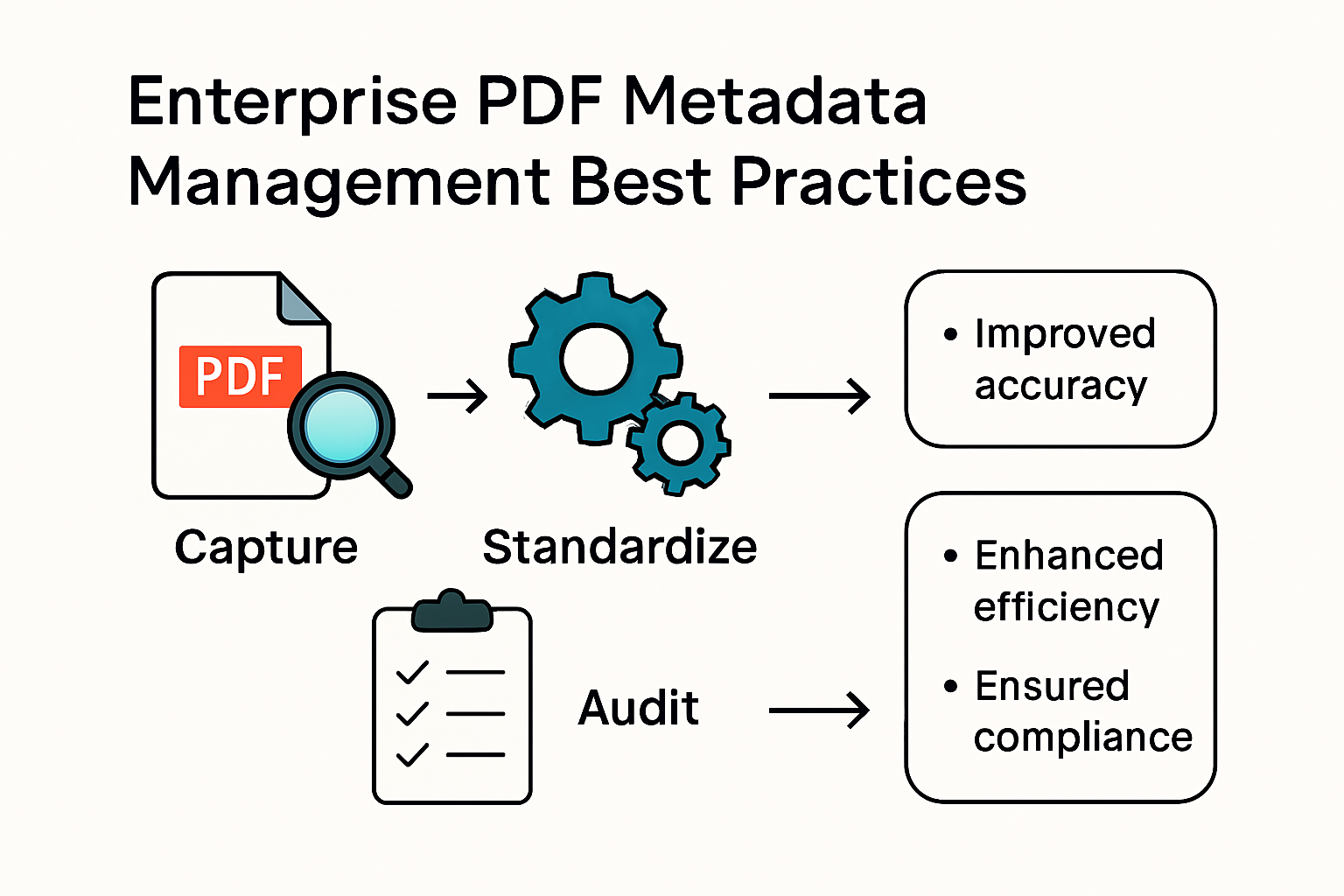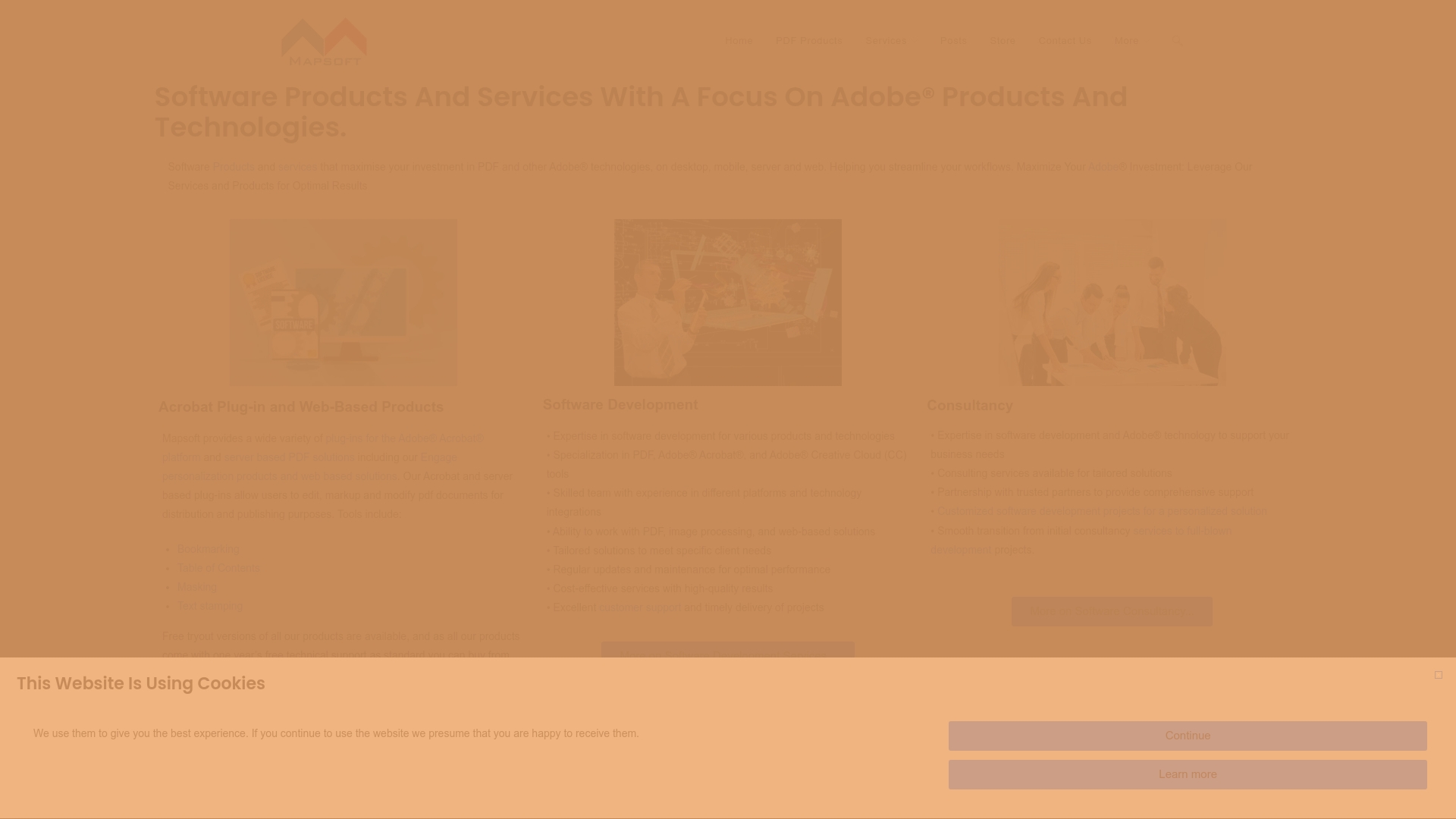PDF metadata shapes everything from how fast you can find a file to how secure your sensitive information stays buried. Yet despite its importance, studies show that over 60 percent of enterprise PDFs have incomplete or inconsistent metadata fields. Most people think of metadata as techy background noise they can ignore. That fast assumption can cost organizations big in compliance, security, and workflow headaches.
Table of Contents
- What Is PDF Metadata And Why It Matters
- Methods For Editing PDF Metadata Effectively
- Best Practices For Enterprise PDF Workflows
- Ensuring Security And Compliance With Metadata
Quick Summary
| Takeaway | Explanation |
|---|---|
| Understand PDF metadata components | Metadata includes title, author, and keywords crucial for document context. |
| Standardize metadata management protocols | Establish guidelines for consistent metadata entry, naming conventions, and regular audits. |
| Leverage advanced editing techniques | Use tools like XMP and AI for precise and efficient metadata management. |
| Implement security measures for metadata | Adopt strategies like metadata scrubbing and access controls to protect sensitive information. |
| Ensure compliance with regulations | Proper metadata management enhances accessibility and aligns with legal standards. |
What Is PDF Metadata and Why It Matters
PDF metadata represents the critical background information embedded within a digital document that goes far beyond what meets the eye. These hidden data layers provide essential context about a file’s origin, creation, and characteristics without being directly visible when the document is opened.
Understanding PDF Metadata Components
Metadata in PDF documents encompasses various informational elements that describe the document’s fundamental properties. According to the U.S. Department of Energy’s digital documentation standards, these components typically include:
- Title: The official name or headline of the document
- Author: The individual or organization responsible for creating the file
- Creation Date: Precise timestamp of document generation
- Keywords: Descriptive terms enabling efficient search and categorization
- Subject: Brief description providing context about the document’s content
These metadata fields serve multiple critical functions in enterprise document management. The National Center for Education Statistics emphasizes that metadata provide foundational context for data, enabling more intelligent information processing and retrieval.
Here is a summary table outlining the key components of PDF metadata commonly found in enterprise documents. This table helps clarify the purpose and function of each metadata field for readers.
| Metadata Component | Description | Purpose |
|---|---|---|
| Title | The official name or headline of the document | Identifies the document for reference and search |
| Author | Individual or organization responsible for creating file | Tracks document provenance and responsibility |
| Creation Date | Precise timestamp of document generation | Establishes creation timeline and version history |
| Keywords | Descriptive terms used for search and categorization | Enhances retrieval and organization |
| Subject | Brief description of document’s content | Provides context about the document |
Enterprise Significance of PDF Metadata
For enterprise users, PDF metadata represents more than simple descriptive information. It becomes a powerful tool for document governance, tracking, and compliance. Proper metadata management ensures:
- Enhanced Document Searchability: Precise keywords and descriptive fields enable rapid information retrieval across large document repositories
- Intellectual Property Protection: Tracking document provenance and creation details helps maintain clear ownership records
- Workflow Optimization: Metadata enables automated sorting, routing, and processing of documents based on embedded information
The PDF Association highlights that comprehensive metadata management supports robust information governance strategies. By maintaining accurate and consistent metadata, organizations can ensure reliable long-term document preservation and accessibility.
For those interested in exploring advanced PDF preservation techniques, read more about long-term digital archiving strategies.
Understanding and managing PDF metadata is not just a technical exercise but a strategic approach to transforming how organizations handle digital documentation. By recognizing metadata’s potential, enterprise users can unlock more intelligent, efficient, and secure document workflows.
Methods for Editing PDF Metadata Effectively
Effective PDF metadata editing requires a strategic approach that balances precision, compliance, and technological capabilities. Enterprise users must understand the sophisticated techniques and tools available for managing document metadata with accuracy and efficiency.
Advanced Metadata Editing Techniques
The Extensible Metadata Platform (XMP) represents a critical standard for metadata management in digital documents.
Developed by Adobe Systems, XMP provides a standardized framework for creating, processing, and exchanging metadata across different platforms and applications. This ISO standard enables organizations to embed and modify metadata consistently without compromising document integrity.
Enterprises can leverage several sophisticated methods for editing PDF metadata:
- Direct Software Editing: Utilizing specialized PDF management tools that offer granular metadata control
- Batch Processing: Applying metadata changes across multiple documents simultaneously
- Automated Metadata Extraction: Using AI-powered tools to identify and populate metadata fields automatically
Technological Approaches to Metadata Management
Cutting-edge research demonstrates advanced approaches to metadata enhancement. According to the MetaEnhance framework research, artificial intelligence can now detect, correct, and standardize metadata with remarkable precision. This technological approach allows organizations to:
- Automatically identify inconsistent or incorrect metadata entries
- Canonicalize metadata across large document repositories
- Improve overall data quality and searchability
The CEDAR Embeddable Editor (CEE) introduces another innovative approach to metadata management. This web-based tool enables seamless integration of structured metadata authoring directly into existing platforms, producing semantically rich metadata in JSON-LD format.
For organizations looking to streamline their document workflows, discover advanced PDF comparison techniques that can complement metadata editing processes.
Successful metadata editing goes beyond simple field modifications. It requires a comprehensive strategy that considers data integrity, searchability, and organizational compliance. By combining technological tools with strategic approaches, enterprise users can transform their document management processes, turning metadata from a mundane administrative task into a powerful information management strategy.
Best Practices for Enterprise PDF Workflows
Enterprise PDF workflows demand a strategic approach that balances efficiency, security, and compliance. Organizations must develop comprehensive strategies to manage digital documents effectively, ensuring seamless information processing and robust metadata governance.
Standardizing Metadata Management Protocols
The National Archives and Records Administration (NARA) emphasizes the critical importance of establishing consistent metadata management protocols. Enterprises should implement comprehensive guidelines that address:
- Uniform Metadata Capture: Creating standardized templates for metadata entry
- Consistent Naming Conventions: Developing clear rules for document and metadata labeling
- Regular Metadata Audits: Scheduling periodic reviews to ensure data accuracy and completeness
According to NARA’s Federal Enterprise Architecture Records Management Profile, effective metadata practices are fundamental to maintaining trustworthy records and supporting long-term information accessibility.
The following checklist table summarizes enterprise best practices for metadata management protocols discussed in this section. Use this table to track adoption or review areas for improvement within your organization.
| Best Practice | Implemented (Yes/No) | Description |
|---|---|---|
| Uniform Metadata Capture | Use standardized templates for consistent metadata entry | |
| Consistent Naming Conventions | Apply clear rules for labeling documents and metadata | |
| Regular Metadata Audits | Schedule periodic reviews to ensure data accuracy/completeness | |
| Workflow Automation | Leverage technology to automate metadata integration | |
| Employee Training and Awareness | Train staff in metadata protocols and compliance |

Implementing Robust Workflow Automation
Modern enterprises can significantly enhance their PDF management capabilities through strategic automation. By leveraging advanced technologies, organizations can:
- Reduce manual data entry errors
- Accelerate document processing times
- Ensure consistent metadata application across large document repositories
For organizations seeking to optimize their document management processes, explore advanced business process automation with Adobe PDF solutions that can transform workflow efficiency.
Successful enterprise PDF workflows require a holistic approach that integrates technological tools, standardized processes, and strategic metadata management. By implementing these best practices, organizations can create more intelligent, secure, and efficient document ecosystems that support critical business operations and decision-making processes.
Enterprise users must recognize that PDF workflow optimization is not a one-time project but an ongoing strategy. Continuous improvement, regular training, and adaptability to emerging technologies will enable organizations to maintain competitive advantages in document management and information governance.

Ensuring Security and Compliance with Metadata
Metadata security represents a critical component of enterprise document management, requiring sophisticated strategies to protect sensitive information and maintain regulatory compliance. Organizations must implement comprehensive approaches to manage metadata risks and protect their digital assets.
Metadata Risk Management Strategies
The United States Court of International Trade highlights significant risks associated with electronic document metadata. Unmanaged metadata can inadvertently disclose sensitive information including authorship, revision histories, and hidden content. Enterprise users must adopt proactive strategies to mitigate these risks:
- Comprehensive Metadata Scrubbing: Systematically removing or sanitizing sensitive metadata before document distribution
- Access Control Mechanisms: Implementing strict permissions and visibility controls for metadata fields
- Regular Metadata Audits: Conducting periodic reviews to identify potential information leakage points
Compliance and Accessibility Considerations
According to the U.S. Environmental Protection Agency, metadata plays a crucial role in document accessibility and regulatory compliance. Properly completed metadata fields ensure:
- Enhanced document searchability
- Improved accessibility for users with disabilities
- Alignment with legal and industry-specific documentation standards
The United States Bankruptcy Court further emphasizes the importance of meticulous metadata management, warning that even encrypted content can potentially be recovered, underscoring the need for comprehensive security protocols.
Enterprise organizations must recognize that metadata security extends beyond simple information protection. It involves creating a holistic approach that balances accessibility, compliance, and confidentiality.
For organizations seeking to enhance their document management strategies, explore advanced version control techniques that can complement metadata security efforts.
Successful metadata security requires a multifaceted approach combining technological solutions, robust policies, and continuous employee training. By treating metadata as a critical asset requiring careful management, enterprises can protect their intellectual property, maintain regulatory compliance, and minimize potential information security risks.
Frequently Asked Questions
What is PDF metadata and why is it important for enterprises?
PDF metadata is hidden information embedded within a PDF document that provides context about its origin, creation, and characteristics. For enterprises, it enhances document searchability, protects intellectual property, and optimizes workflows by enabling efficient information retrieval and management.
How can I edit PDF metadata effectively?
Effective PDF metadata editing can be achieved through various methods, including using specialized PDF management tools for direct editing, implementing batch processing to update multiple documents at once, and utilizing AI-powered tools to automate metadata extraction and population.
What best practices can enterprises follow for managing PDF metadata?
Enterprises should standardize metadata management protocols by using uniform templates for metadata capture, applying consistent naming conventions, conducting regular audits, and leveraging workflow automation tools to enhance accuracy and efficiency.
What risks are associated with unmanaged PDF metadata?
Unmanaged PDF metadata can inadvertently expose sensitive information such as authorship, revision histories, and hidden content. To mitigate these risks, organizations should adopt comprehensive metadata scrubbing, access control mechanisms, and regular audits to prevent information leakage.
Take Control of Your Enterprise PDF Metadata—Effortlessly
Are inconsistent PDF metadata fields slowing down your team’s workflow and exposing your business to unnecessary risk? If security breaches, compliance headaches, or inefficient document searching sound familiar, it is time to reimagine your metadata management process. Mapsoft delivers the advanced automation and precision you need for enterprise-level PDF editing, including dedicated solutions for metadata cleansing, batch processing, and compliance.

With Mapsoft.com, you can quickly:
- Standardize metadata management with robust templates and automated batch tools
- Scrub and secure sensitive metadata to stay ahead of compliance requirements
- Streamline PDF workflows through our PDF Hub for transforming, editing, and analyzing files at scale
Ready to eliminate document chaos and stay in control of your enterprise information? Discover how Mapsoft PDF solutions can empower your team to work faster and stay fully compliant. Start boosting your productivity today and never worry about missing metadata again.
Recommended
- Creating Searchable PDFs: Best Practices for 2025 Workflow – Mapsoft
- Exciting PDF Accessibility Guidelines for Business Empowerment
- Document Version Control for Businesses in 2025: Best Practices and Adobe Solutions – Mapsoft
- Collaboration Across Teams with Adobe: 2025 Strategies for Success – Mapsoft



